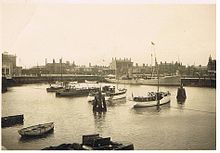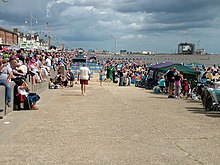Lowestoft
Flint tools discovered in the Pakefield cliffs of south Lowestoft in 2005 allow human habitation of the area to be traced back 700,000 years.
Sir Samuel Morton Peto's arrival in 19th-century Lowestoft brought a change in the town's fortunes, including its fishing industry.
[13] To help stimulate this, Peto was given the task of building a line for the Lowestoft Railway and Harbour Company, connecting with Reedham and the city of Norwich.
The port was a major naval base during the war, including for armed trawlers such as Ethel & Millie and Nelson used to combat German U-boat actions in the North Sea such as that of 15 August 1917.
The seats, fourteen in all, are allocated to Carlton and Whitton (2), Gunton and St. Margarets (2), Harbour and Normanston (3), Kirkley and Pakefield (3), Lothingland (1), and Oulton Broad (3).
[26] After the inaugural 2019 East Suffolk District Council election of 2 May, eight of the fourteen Lowestoft seats over the six new wards went to the Conservatives and six to Labour.
[30] The rock beneath is crag-sand with overlying sand and glacial till deposits with gravel, with the crag exposed at coastal cliffs such as Pakefield's.
[60] The food-processing company Wessex Foods closed its Lowestoft plant in 2010 after a fire destroyed the factory and it failed to find alternative premises.
[69][70] The non-profit Orbis Energy centre has been set up to draw business in the green-energy sector and features solar thermal heating.
[71][72][73][74] In April 2009, Associated British Ports announced that the harbour is to become the operations centre for the 500 MW Greater Gabbard wind farm, which when completed will be the world's largest offshore windfarm.
Chadds independent department store was founded in 1907, and after nearly 100 years trading in the High Street, was taken over in 2004 by the Great Yarmouth-based Palmers group.
[79][80] Specialist shopping areas, branded as The Historic High Street and the Triangle Market Place, have been developed on the northern edge of the centre.
A major attraction, the two-day event took place in August, and featuring a wide range of aircraft including the Red Arrows, a Lancaster bomber, Spitfires and an Avro Vulcan.
[87][88][89] Near the town centre is Lowestoft Maritime Museum, open from late April to late October, which has exhibits of maritime artefacts, an extensive collection of ship models and medals, marine art, fishing and the fishing industry, activities with the Royal Navy in WWII, and shipwrights' and coopers' tools.
The Waveney Sunrise Scheme invested £14.7 million, funding transport improvements and tourist facilities such as fountains on Royal Plain, as stimulants.
[96] The plan focuses on the redevelopment of brownfield sites in and around the harbour area to create jobs, particularly in the renewable energy and retailing sectors.
[108] At the most easterly point is a large compass rose, the Euroscope, set in the ground to give the direction and distance to various cities in Europe.
The Low Light was discontinued in 1706 after sea encroachment, but re-established in 1730 in a form that could be easily moved in response to further changes to the Stamford Channel and shoreline.
[113] Lowestoft Lifeboat Station, at the mouth of the outer harbour at the South Pier, is one of Britain's oldest, founded in 1801 and open to visitors throughout the year.
[124] The Northern Approach Viaduct (NAV) has ground clearance of around 6-metre (20 ft) over the railway line to Lowestoft station for trains.
The main A12 road to London passes through Carlton Colville, Pakefield and Kirkley in the southern area of Lowestoft, ending at the town's harbour Bascule Bridge.
[69] Both bridges can be raised if vessels need to pass through the harbour and Lake Lothing, though this can cause congestion in the town and routes can become gridlocked.
[152] The Elizabethan pamphleteer Thomas Nashe, a father of modern journalism and a primary source for the literary milieux of William Shakespeare, was born in Lowestoft in 1567.
Lieutenant General Sir Edwin Alderson also lived at Oulton Broad, on a houseboat, and died in 1927 at the since-demolished Royal Hotel in Lowestoft, where he had been staying for his last month.
[154] Admiral Sir John Ashby, who commanded HMS Victory at the Battles of Barfleur and La Hogue in 1692, grew up in Suffolk and is buried in Lowestoft.
He lived in a family house in High Street until his victories enabled him to move to a grander country residence, Somerleyton Hall.
Sir Christopher Cockerell, inventor of the hovercraft, lived at Oulton Broad, and tested craft in Somerleyton at Fritton Lake.
He has been called "without a doubt the greatest English classical composer of the last century"[157] and "the only person of real celebrity to have emerged from darkest Lowestoft.
[160] Sports people associated with Lowestoft include the England football captain Terry Butcher, who was educated there, and Peter Wright, a Darts World Champion who spent formative years there.
Others include former Ipswich Town goalkeeper Laurie Sivell, Norwich City defenders Paul Haylock and Daryl Sutch, former football player and manager Richard Money, New York Mets pitcher Les Rohr and Olympic Bronze medal-winning middleweight boxer Anthony Ogogo.








